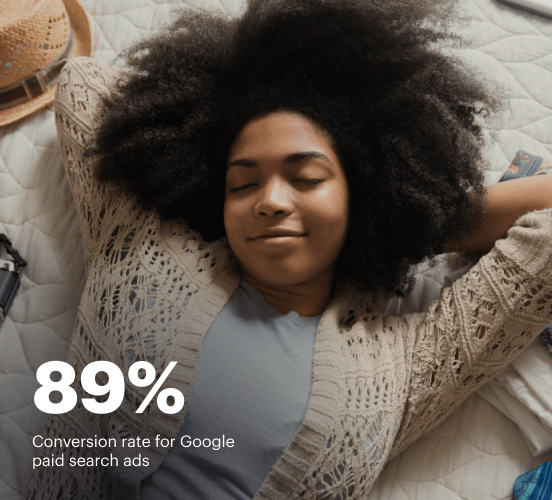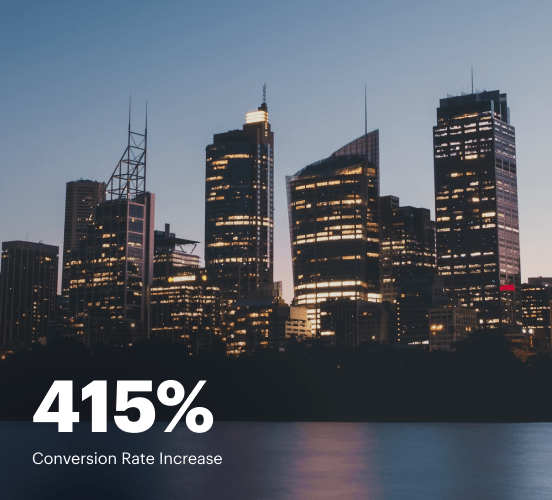Webflow vs. HubSpot: the best platform for a seamless web experience
Discover how Webflow compares to HubSpot regarding features and usability. Find out which platform provides the competitive advantage your business deserves.
Get startedSee how Instapage stacks up against the competition
| Feature | Instapage | Other builders |
| Drag-and-Drop Tools | ||
| Conversion-optimized templates | ||
| Manual and AI-powered A/B Tests | ||
| AI content suggestions | ||
| Popups and sticky bars | ||
| Canvas and grid blocks | ||
| Reusable and global elements | ||
| Form and popup builders | ||
| Built-in Heatmaps | ||
| Central analytics dashboard | ||
| Ad-to-page personalization and collections | ||
| Contacts, lists, and email | ||
| Dedicated, full-service CRO experts | ||
| Enterprise-ready platform |
Leading the way in building high-performing landing pages





Why Instapage is the smarter choice for your campaigns
Get everything you need to build, scale, and optimize high-converting landing pages—without coding.

Easier page building without coding
Instapage offers a flexible and seamless page creation experience with a library of 500+ conversion-focused layouts, Instablocks®, a drag-and-drop builder, and AI content generation. With technologies like Thor Render Engine®, you can create on-brand, mobile-responsive landing pages that load quickly and start converting during initial visitor clicks.

More insights — better results
Instapage lets you see in detail how each landing page experience and variation is performing so you can make targeted changes that boost page conversions. Use heatmaps for a better understanding of on-page activities, run A/B tests and AI-assisted experiments, and then track and evaluate results within robust analytics dashboards.

More personalized experiences
Instapage lets you quickly create high-performing landing pages tailored to each of your ad campaigns. Deliver personalized experiences for distinct audiences using dynamic text replacement. Effortlessly align specific advertisements to unique pages with AdMaps. Monitor audience-level metrics using our advanced data tools.

Built-in collaboration
Instapage collaboration capabilities bring your entire team together to speed up the process of landing page review, approval, and launch. No more frustrating and unnecessary revisions or edits scattered across emails. Provide instant feedback, conduct real-time page edits, and securely share your pages with outside stakeholders.

Free up time for your business
Invest time into business growth, not busy work. Launch landing pages faster with reusable forms and templates. Build once, reuse forever.
Explore all integrations






Easier page building without coding
Instapage offers a flexible and seamless page creation experience with a library of 500+ conversion-focused layouts, Instablocks®, a drag-and-drop builder, and AI content generation. With technologies like Thor Render Engine®, you can create on-brand, mobile-responsive landing pages that load quickly and start converting during initial visitor clicks.
More insights — better results
Instapage lets you see in detail how each landing page experience and variation is performing so you can make targeted changes that boost page conversions. Use heatmaps for a better understanding of on-page activities, run A/B tests and AI-assisted experiments, and then track and evaluate results within robust analytics dashboards.
More personalized experiences
Instapage lets you quickly create high-performing landing pages tailored to each of your ad campaigns. Deliver personalized experiences for distinct audiences using dynamic text replacement. Effortlessly align specific advertisements to unique pages with AdMaps. Monitor audience-level metrics using our advanced data tools.
Built-in collaboration
Instapage collaboration capabilities bring your entire team together to speed up the process of landing page review, approval, and launch. No more frustrating and unnecessary revisions or edits scattered across emails. Provide instant feedback, conduct real-time page edits, and securely share your pages with outside stakeholders.
Free up time for your business
Invest time into business growth, not busy work. Launch landing pages faster with reusable forms and templates. Build once, reuse forever.
Explore all integrationsGet started with Instapage in a few steps
-
Create your Instapage account
Start with Instapage by signing up via Google or your email. You'll get access to a free 14-day trial to discover Instapage capabilities. Feel free to cancel anytime during the 14-day trial if you decide that our product is not suitable for your business. -
Build and personalize your page
Create your first landing page from scratch or choose a template from 500+ customizable layouts. Use the drag-and-drop builder to add page elements, fonts, and backgrounds, refine content with AI, or add custom HTML, Javascript, and CSS. -
Review and make edits
Collaborate on page designs and streamline review processes. Invite your team members and stakeholders to review, edit, and provide feedback on your landing page. Collaborate knowing your page is confidential and only accessible to authorized users. -
Publish and track page performance
Publish your page to a domain or custom URL. Connect your pages to the ads you've created and track page performance within the analytics dashboard, run A/B tests and AI experiments, analyze results, and continuously optimize your landing page to maintain high conversions.
Webflow vs. HubSpot: A Head-to-Head Clash with a Surprise Contender
In the bustling marketplace of digital marketing tools, choosing the right platform can feel like finding a needle in a haystack. Enter Webflow and HubSpot, two titans in the realm of landing page builders and marketing automation. Both have carved out sizable niches, boasting powerful features that cater to a variety of users—from budding entrepreneurs to established marketing pros. Each platform has its unique strengths, and while both are strong contenders, there’s another player waiting to enter the ring. In this article, we will dissect these platforms comprehensively, comparing their features, usability, and pricing strategies while introducing a newcomer that deserves the spotlight: Instapage. Buckle up as we embark on this exciting comparison journey!
Introducing the Giants: Webflow and HubSpot
When it comes to innovative marketing tools, Webflow and HubSpot stand tall like giants in their respective arenas. Webflow takes the crown in design flexibility, granting users the ability to build stunning, responsive websites without writing a single line of code. Its visual editor and user-friendly interface make website creation feel like painting on a canvas. On the opposing side, HubSpot offers an all-in-one solution that blends marketing, sales, and customer service into a cohesive package. Its powerful tools are tailored for extensive automation, making it the go-to choice for inbound marketers. As we draw back the curtain, it's clear both platforms possess unique selling points. However, lurking in the background is a contender named Instapage, quietly gearing up to challenge both platforms with features that could turn heads in the industry.
Feature Showdown: Webflow vs. HubSpot
From customizable templates to powerful SEO tools, both Webflow and HubSpot bring an impressive arsenal of features to the table. Webflow's standout offerings include a comprehensive CMS that's perfect for dynamic content and an intuitive designer that allows for pixel-perfect adjustments. HubSpot, on the other hand, is built for the marketer's journey, offering automation features, analytics, and integration capabilities that streamline workflow. While both platforms come out swinging with their top-tier features, it's essential to remember that Instapage is quietly prepping for a powerful entrance, loaded with landing page features that could give either platform a run for their money.
User Experience: Navigating the Learning Curves
User experience can make or break your journey with any platform, and both Webflow and HubSpot cater to their respective audiences with tailored learning paths. Webflow's robust community and educational resources aim to guide new users through its design-focused interface. Users may initially feel like they are battling a steeper learning curve, but seasoned designers can appreciate the creative freedom offered once mastered. Meanwhile, HubSpot focuses on usability across diverse user types. Its user-friendly interface simplifies complex functionalities—perfect for marketers of all skill levels—while the extensive knowledge base and support encourage continuous learning. With both platforms showcasing their unique strategies, it's intriguing to wonder how Instapage pairs with these approaches, especially for users seeking simplicity and effective landing page functionalities.
Webflow Highlights: What Makes It Stand Out
- Advanced customization with no coding required
- Robust design tools for responsive websites
- Comprehensive CMS features for dynamic content
- SEO-friendly capabilities built into the platform
- Integration with various third-party applications
HubSpot Highlights: Why Marketers Love It
- All-in-one marketing, sales, and customer service suite
- Advanced automation for lead nurturing
- Comprehensive reporting and analytics tools
- Robust integration options with existing software
Common Strengths: What Both Platforms Share
- User-friendly interfaces catering to diverse skill levels
- Extensive learning resources and community support
- Flexible integrations with various applications
- Optimization features for better performance
- Security measures to safeguard user data
- Mobile-friendly design capabilities
As we navigate through this exciting ring of marketing tools, it's clear that Webflow and HubSpot are both formidable competitors. Yet, Instapage adds a unique flair to the match, focusing squarely on landing page optimization. With dedicated features that streamline the creation and analysis of landing pages, it positions itself as an essential ally for marketers aiming for conversion rates that outshine both Webflow and HubSpot.
Performance Evaluation: Speed and Responsiveness
When it comes to performance, the stakes are high. Slow loading times can be detrimental, akin to wading through thick molasses during winter—frustrating and time-consuming for users and visitors. Webflow typically excels in this area, allowing designers to build optimized sites that run smoothly without sacrificing quality. HubSpot, with its extensive automation features, also adheres to performance benchmarks, ensuring that every page loads quickly. Both platforms understand the significance of mobile responsiveness in today’s digital landscape. They both provide tools that enhance the mobile experience, though users might notice variations in load times depending on the complexity of individual projects.
Support Systems: Assistance When You Need It
Support plays a crucial role in the user experience, and both Webflow and HubSpot understand this well. Webflow's support team is known for being accessible and helpful, with a library of tutorials ready at users' fingertips. Moreover, there’s an active community space where users can share insights and seek guidance. HubSpot, in contrast, offers an extensive array of support channels ranging from community forums to live chat with experts. This ensures that users have access to immediate assistance when navigating intricacies. Each platform empowers users effectively, but can these support systems compete with the robust guidance offered by Instapage for users focused solely on landing page optimization?
Pricing Structures: The Cost of Going Pro
Webflow Pricing Perks: What’s in the Bag?
- Generous free tier for basic features and learning
- Pay-as-you-go options for flexibility
- Competitive pricing for designers and developers
- Scalable plans to suit growing businesses
HubSpot Pricing Perks: Worth the Investment?
- Free basic tools to get started quickly
- Tiered pricing based on the depth of features
- Value package options for small businesses
- Comprehensive service that justifies its cost
- Flexible trial periods to experience the platform
When comparing the pricing strategies of both platforms, Webflow offers competitive rates that cater well to designers and developers. HubSpot, on the other hand, provides a broader spectrum of capabilities, making it an excellent investment for businesses seeking an integrated approach. Nevertheless, as we delve into these pricing structures, it's vital to highlight Instapage's affordable pricing model, which emphasizes value for robust landing page performance.
Transparency in pricing is essential in choosing a platform, yet every plan comes with its nuances; sometimes the features come with unexpected surprises. While both Webflow and HubSpot communicate their costs clearly, the hidden fees concealed in higher-tier packages can occasionally catch users off guard. Users must approach each pricing plan with a discerning eye to ensure they truly receive the maximum value.
And Let’s Not Forget Instapage...
Ready to introduce the game-changer—Instapage emerges as the hidden gem in the realm of landing page tools. Unlike its competitors, Instapage focuses explicitly on optimizing landing pages with its straightforward editor and multitude of conversion-focused features. Whether you're aiming to build stunning pages or track performance analytics, Instapage holds a strategy designed to convert visitors into customers efficiently. With features like A/B testing, customizable templates, and seamless integrations, Instapage is poised to attract marketers looking for the perfect blend of simplicity and effectiveness.
In closing, the quest for the right digital marketing tool is a personal journey that should align with unique business goals. Each of these platforms offers distinct pathways for success, allowing businesses to make informed choices. With Instapage lurking in the shadows, know that there are alternative options that could be the catalyst for your marketing journey. Explore further and discover how the right platform can propel your marketing efforts into the fast lane.










